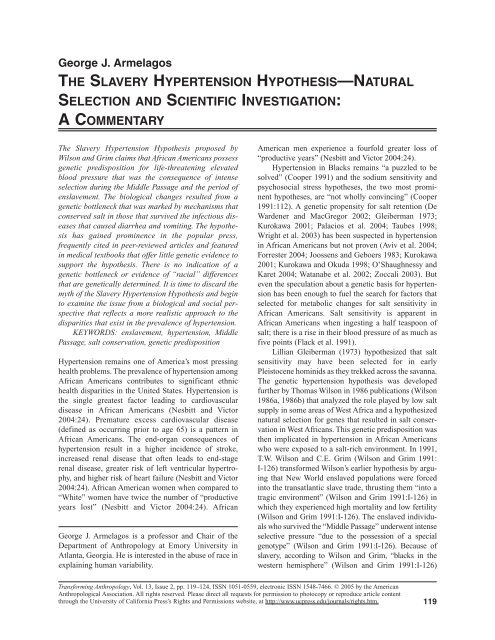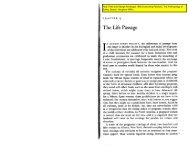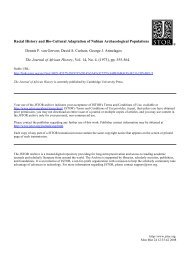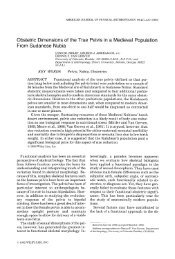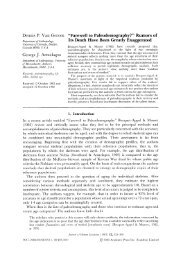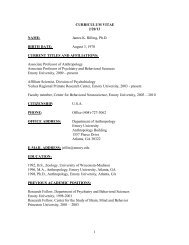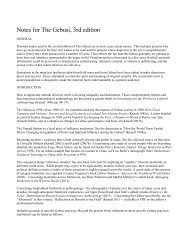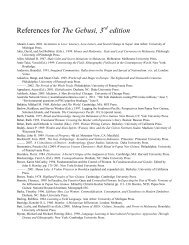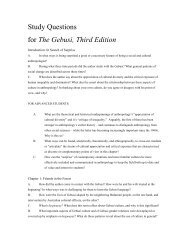THE SLAVERY HYPERTENSION HYPOTHESIS ... - ResearchGate
THE SLAVERY HYPERTENSION HYPOTHESIS ... - ResearchGate
THE SLAVERY HYPERTENSION HYPOTHESIS ... - ResearchGate
Create successful ePaper yourself
Turn your PDF publications into a flip-book with our unique Google optimized e-Paper software.
08.TRAN.13_119-124.qxd 06/07/2005 22:15 Page 119<br />
George J. Armelagos<br />
<strong>THE</strong> <strong>SLAVERY</strong> <strong>HYPERTENSION</strong> HYPO<strong>THE</strong>SIS—NATURAL<br />
SELECTION AND SCIENTIFIC INVESTIGATION:<br />
A COMMENTARY<br />
The Slavery Hypertension Hypothesis proposed by<br />
Wilson and Grim claims that African Americans possess<br />
genetic predisposition for life-threatening elevated<br />
blood pressure that was the consequence of intense<br />
selection during the Middle Passage and the period of<br />
enslavement. The biological changes resulted from a<br />
genetic bottleneck that was marked by mechanisms that<br />
conserved salt in those that survived the infectious diseases<br />
that caused diarrhea and vomiting. The hypothesis<br />
has gained prominence in the popular press,<br />
frequently cited in peer-reviewed articles and featured<br />
in medical textbooks that offer little genetic evidence to<br />
support the hypothesis. There is no indication of a<br />
genetic bottleneck or evidence of “racial” differences<br />
that are genetically determined. It is time to discard the<br />
myth of the Slavery Hypertension Hypothesis and begin<br />
to examine the issue from a biological and social perspective<br />
that reflects a more realistic approach to the<br />
disparities that exist in the prevalence of hypertension.<br />
KEYWORDS: enslavement, hypertension, Middle<br />
Passage, salt conservation, genetic predisposition<br />
Hypertension remains one of America’s most pressing<br />
health problems. The prevalence of hypertension among<br />
African Americans contributes to significant ethnic<br />
health disparities in the United States. Hypertension is<br />
the single greatest factor leading to cardiovascular<br />
disease in African Americans (Nesbitt and Victor<br />
2004:24). Premature excess cardiovascular disease<br />
(defined as occurring prior to age 65) is a pattern in<br />
African Americans. The end-organ consequences of<br />
hypertension result in a higher incidence of stroke,<br />
increased renal disease that often leads to end-stage<br />
renal disease, greater risk of left ventricular hypertrophy,<br />
and higher risk of heart failure (Nesbitt and Victor<br />
2004:24). African American women when compared to<br />
“White” women have twice the number of “productive<br />
years lost” (Nesbitt and Victor 2004:24). African<br />
George J. Armelagos is a professor and Chair of the<br />
Department of Anthropology at Emory University in<br />
Atlanta, Georgia. He is interested in the abuse of race in<br />
explaining human variability.<br />
American men experience a fourfold greater loss of<br />
“productive years” (Nesbitt and Victor 2004:24).<br />
Hypertension in Blacks remains “a puzzled to be<br />
solved” (Cooper 1991) and the sodium sensitivity and<br />
psychosocial stress hypotheses, the two most prominent<br />
hypotheses, are “not wholly convincing” (Cooper<br />
1991:112). A genetic propensity for salt retention (De<br />
Wardener and MacGregor 2002; Gleiberman 1973;<br />
Kurokawa 2001; Palacios et al. 2004; Taubes 1998;<br />
Wright et al. 2003) has been suspected in hypertension<br />
in African Americans but not proven (Aviv et al. 2004;<br />
Forrester 2004; Joossens and Geboers 1983; Kurokawa<br />
2001; Kurokawa and Okuda 1998; O’Shaughnessy and<br />
Karet 2004; Watanabe et al. 2002; Zoccali 2003). But<br />
even the speculation about a genetic basis for hypertension<br />
has been enough to fuel the search for factors that<br />
selected for metabolic changes for salt sensitivity in<br />
African Americans. Salt sensitivity is apparent in<br />
African Americans when ingesting a half teaspoon of<br />
salt; there is a rise in their blood pressure of as much as<br />
five points (Flack et al. 1991).<br />
Lillian Gleiberman (1973) hypothesized that salt<br />
sensitivity may have been selected for in early<br />
Pleistocene hominids as they trekked across the savanna.<br />
The genetic hypertension hypothesis was developed<br />
further by Thomas Wilson in 1986 publications (Wilson<br />
1986a, 1986b) that analyzed the role played by low salt<br />
supply in some areas of West Africa and a hypothesized<br />
natural selection for genes that resulted in salt conservation<br />
in West Africans. This genetic predisposition was<br />
then implicated in hypertension in African Americans<br />
who were exposed to a salt-rich environment. In 1991,<br />
T.W. Wilson and C.E. Grim (Wilson and Grim 1991:<br />
I-126) transformed Wilson’s earlier hypothesis by arguing<br />
that New World enslaved populations were forced<br />
into the transatlantic slave trade, thrusting them “into a<br />
tragic environment” (Wilson and Grim 1991:I-126) in<br />
which they experienced high mortality and low fertility<br />
(Wilson and Grim 1991:I-126). The enslaved individuals<br />
who survived the “Middle Passage” underwent intense<br />
selective pressure “due to the possession of a special<br />
genotype” (Wilson and Grim 1991:I-126). Because of<br />
slavery, according to Wilson and Grim, “blacks in the<br />
western hemisphere” (Wilson and Grim 1991:I-126)<br />
Transforming Anthropology, Vol. 13, Issue 2, pp. 119–124, ISSN 1051-0559, electronic ISSN 1548-7466. © 2005 by the American<br />
Anthropological Association. All rights reserved. Please direct all requests for permission to photocopy or reproduce article content<br />
through the University of California Press’s Rights and Permissions website, at http://www.ucpress.edu/journals/rights.htm.<br />
119
08.TRAN.13_119-124.qxd 06/07/2005 22:15 Page 120<br />
may be different from “today’s blacks in Africa”<br />
(Wilson and Grim 1991:I-126). The high mortality during<br />
the Middle Passage followed by the period of enslavement<br />
was caused “largely by salt- and water-depletive diseases”<br />
(Wilson and Grim 1991:I-126) resulting in a genetic<br />
change in sodium metabolism (Wilson and Grim<br />
1991:I-126). This “enhanced genetic-based ability to<br />
conserve salt” (Wilson and Grim 1991:I-122) is more<br />
prevalent among “western hemisphere blacks than<br />
among African blacks” (Wilson and Grim 1991:I-126)<br />
and may have subsequently resulted in a higher prevalence<br />
of hypertension in African Americans.<br />
There is one assumption and three lines of evidence<br />
that are used to support their hypothesis. While Wilson<br />
and Grim (1991:I-125) cite Grollmann’s (1978) observation<br />
that the hypothesis is “impossible to verify,” they<br />
believed that the extensive information now available on<br />
the “biohistory of blacks” (Wilson and Grim 1991:I-125)<br />
made it possible to test the hypothesis. They started with<br />
an assumption that early Paleolithic hominids living in a<br />
hot and salt-depleted savanna environment evolved an<br />
ability to conserve salt (Gleiberman 1973). This scenario<br />
assumes that water was conserved because of<br />
excessive sweating (Newman 1970). First, “Blacks,”<br />
Wilson and Grim claim, are more sensitive to salt, with<br />
an enhanced genetic ability to retain sodium. Initially,<br />
Wilson and Grim saw this as a problem with “defective<br />
kidneys” (Wilson and Grim 1991:I-123) and “renal<br />
defects that could not excrete salt effectively” (Wilson<br />
and Grim 1991:I-123). Second, the high mortality during<br />
the Middle Passage was due to “conditions that ultimately<br />
kill by salt and water depletion” (Wilson and<br />
Grim 1991:I-125). Vomiting, sweating, and diarrheal<br />
diseases were causes of sodium depletion during the<br />
Middle Passage. Third, high mortality during the period<br />
of enslavement continued to select for sodium retention<br />
because of intensive heat and punishing physical labor<br />
(Wilson and Grim 1991:I-125–I-126).<br />
Fatimah L.C. Jackson (1991) supported the argument<br />
for the selection for salt retention during the<br />
Middle Passage. 1 She believed that this intense selective<br />
mortality resulted in a genetic bottleneck (a constriction<br />
of existing genetic variability [Poston et al. 2001]) for<br />
salt conservation. She offers an interesting addition to<br />
the Wilson-Grim hypothesis by suggesting that the<br />
stress experienced by enslaved populations may have<br />
increased genetic variability. Using experimental evidence<br />
from drosophila that suggests environmental<br />
stress as a mechanism for increasing genetic variation,<br />
she argues that there would have been a “burst” of point<br />
mutations and an increase in genetic recombination that<br />
would increase variability in populations that survived<br />
the Middle Passage. Even if there was this unlikely<br />
“burst” of diversity in enslaved populations, there should<br />
120 TRANSFORMING ANTHROPOLOGY 2005 VOL. 13 (2)<br />
be evidence of salt conservation in the descendants that<br />
survived the Middle Passage. A recent genetic analysis<br />
(Poston et al. 2001) in a sample of U.S.-born African<br />
Americans and African-born immigrants used alleles<br />
associated with hypertension risk (G-protein, AGT-235,<br />
and ACE I/D) to test for evidence of a genetic bottleneck<br />
in U.S.-born African Americans that would<br />
support the Slavery Hypertension Hypothesis. In fact,<br />
the research showed an association of the AGT-235<br />
homozygous T genotype with African-born immigrants.<br />
This finding counters the notion of a bottleneck in the<br />
survivors of the Middle Passage.<br />
The renowned historian Phillip D. Curtin (1992)<br />
provides a devastating analysis of Wilson and Grim’s<br />
logic as well as the demographics and historical data<br />
used to bolster their argument. Curtin (1992:1686) evaluates<br />
Wilson and Grim’s arguments by saying that the<br />
Slavery Hypertension Hypothesis lacks supporting evidence<br />
and “runs counter to what evidence we do have.”<br />
Curtin questioned Wilson and Grim’s use of “African<br />
American” as a biological marker (Curtin 1992:1681);<br />
their misuse of historical sources (Curtin 1992:1683);<br />
the size of enslaved population transported during the<br />
Middle Passage (Curtin 1992:1683); the cause and the<br />
rates of mortality during the Middle Passage (Curtin<br />
1992:1684); the availability of salt on the slave ships<br />
(Curtin 1992:1682); the misinterpretation of his<br />
(Curtin’s) accounts of the slave trade, miscalculating the<br />
availability of salt in Africa (Curtin 1992:1682); and the<br />
failure to describe the salt trade (Curtin 1992:1682).<br />
Furthermore, Curtin notes that the popularization of<br />
this story (Diamond 1991) both selectively misrepresents<br />
the evidence (Curtin 1992:1684) from Wilson<br />
and Grim and presents the hypothesis as proven.<br />
Publications that use data to distort reality increase the<br />
gap between scientific and historical knowledge, and<br />
this concerns Curtin (1992:1686).<br />
The popularization of the Slavery Hypertension<br />
Hypothesis (Kaufman and Hall 2003a, 2003b) is evident<br />
in how it was reported extensively in the newspaper,<br />
magazines (Diamond 1991), and review articles that<br />
appear in medical journals and textbooks. For example,<br />
Joel E. Dimsdale (2000) in “Stalked by the Past,” his<br />
presidential address to the American Psychosomatic<br />
Society, describes how our biological past influences the<br />
health of contemporary ethnic groups. Dimsdale<br />
(2000:164) uses the relationship between salt and slavery<br />
as one of his prime example of how the past stalks<br />
the present. Building on his earlier research (Dimsdale<br />
et al. 1990) on salt ingestion in four groups (Blacks,<br />
Whites, normotensives, and hypertensives), Dimsdale<br />
and colleagues found that “salt sensitivity was found in<br />
only one group of individuals—black hypertensives.”<br />
While noting that the genetic basis for salt sensitivity
08.TRAN.13_119-124.qxd 06/07/2005 22:15 Page 121<br />
has reached little consensus, he nevertheless claims that<br />
there are “unique historical sources” (Dimsdale<br />
2000:165) to support the Slavery Hypertension<br />
Hypothesis. Using the arguments derived from Wilson<br />
and Grim (1991), Dimsdale repeats the Slavery<br />
Hypertension story, saying that those who survived<br />
enslavement “would be less likely to sustain lethal<br />
electrolyte abnormalities” (Dimsdale 2000:165). While<br />
he describes the Slavery Hypertension Hypothesis as<br />
“sheer speculation because, to date, the frequency of<br />
alleles—at least for the renin-angiotensin system—is<br />
similar in Blacks from West Africa and the United<br />
States, nevertheless the hypothesis remains an intriguing<br />
one” (Dimsdale 2000:165). He then quotes a<br />
passage from Moby Dick describing sharks trailing<br />
slave ships (Dimsdale 2000:165), scavenging the bodies<br />
thrown overboard. He also describes a 1794 engraving<br />
in which a slave trader is licking the cheek of an “African<br />
captive” to taste his sweat (Dimsdale 2000:166).<br />
Dimsdale claims that this illustrates a test to determine<br />
if the sweat was salty, which would indicate an inability<br />
to conserve salt and making it less likely that the enslaved<br />
individual would be able to survive the Middle<br />
Passage. Dimsdale is quick to point out that these<br />
assertions are difficult to evaluate because of the “distance<br />
of time” but are suggestive “of a genetic legacy<br />
from the middle passage, a historical legacy accounting<br />
for increased salt retention and thereby accounting for<br />
increased salt retention and thereby increased salt<br />
sensitivity in blacks” (Dimsdale 2000:166).<br />
Kaufman (2001) was quick to respond to<br />
Dimsdale’s results, saying that his analysis was a “careless<br />
repetition” of the old “slavery hypothesis” yarn.<br />
Dimsdale (2001) defends the details of his assessment,<br />
saying that his mortality estimates and the use of contemporary<br />
evidence from Melville’s description of<br />
sharks trailing slave ships support the validity of the<br />
“slavery hypothesis.” He admonishes Kaufman’s criticism<br />
as a politicalization of the issue. Dimsdale states,<br />
“Race and ethnicity are too important to be ignored or<br />
politicized.” Lillian Gleiberman (Gleiberman and<br />
Dimsdale 2001) supports Dimsdale’s interpretation,<br />
saying it exemplifies the “ideas and principle of<br />
Darwinian medicine and it is important for these ideas<br />
to move into the mainstream of medical research”<br />
(Nesse and Williams 1994). While she sees the hypothesis<br />
as “intriguing,” she also notes that the genotype<br />
frequencies for the rennin-angiotensin system are similar<br />
for West Africans in the African Americans in the<br />
United States. If the African American descendants of<br />
enslaved populations went through the Middle Passage,<br />
they should show differences in genotype frequencies.<br />
Kaufman and Hall (2003a) continued a frontal<br />
attack on the Slavery Hypertension Hypothesis. They<br />
discuss in detail the “career” of the hypothesis from its<br />
presentation at national meetings in 1989 and 1990 to<br />
the single peer-reviewed publication (Wilson and Grim<br />
1991) and two decades of publication in book chapters,<br />
textbooks, and popular press. They are especially concerned<br />
with the lack of experimental evidence that supports<br />
the Slavery Hypertension Hypothesis. In fact,<br />
there appears to be nearly an inverse relationship<br />
between the reports in the popular press and a definitive<br />
scientific finding that supports the Slavery Hypertension<br />
Hypothesis. Kaufman and Hall show how the language<br />
used in these popular treatments contributes to a notion<br />
that “Blacks” are inherently different by harboring<br />
genetic defects or physiological abnormalities (Kaufman<br />
and Hall 2003a). While terms such as “defective<br />
kidneys” (Wilson and Grim 1991:I-123) and “renal<br />
defects” (Wilson and Grim 1991:I-123) have been<br />
disavowed, Kaufman and Hall (2003a) describe titles in<br />
medical journals that present hypertension in Blacks as a<br />
different disease (Meggs 1985) and as “a paradigm of<br />
metabolic disarray” (Weir and Hanes 1996). Descriptions<br />
such as these essentialize race and present an image of<br />
Blacks as being fundamentally different in their genetic<br />
makeup and that this increases their risk for disease. The<br />
Slavery Hypertension Hypothesis reinforces “notions of<br />
genetic determinism” (Kaufman and Hall 2003a) and the<br />
“essential black abnormality” (Kaufman and Hall 2003a)<br />
that blames the victim and displaces economic or cultural<br />
factors from our understanding of the underlying etiology<br />
of the disease process.<br />
Kaufman and Hall’s criticism that Grim and<br />
Robinson essentialize race was interpreted by Grim and<br />
Robinson as their being called racist (Grim and Robinson<br />
2003). Racism was never used or implied in any of the<br />
discussion. In their continuing defense of the Slavery<br />
Hypertension Hypothesis, Grim and Robinson (2003) cite<br />
more demographic evidence that enumerates the mortality<br />
involved in the process of enslavement. While they<br />
claim to be testing a hypothesis, their approach reflects a<br />
strategy of advocacy to make their case by marshaling<br />
more evidence about the impact of the Middle Passage. A<br />
primary problem is that they avoid the essential point of<br />
defining a racial (genetic) difference in hypertension risk<br />
among African Americans. This point is brought home<br />
when they ask the question, “Do African populations<br />
metabolize sodium differently than Europeans or African<br />
Americans?”; they answer, “We do not know.” Any scientific<br />
test should begin with evidence that there is a genetic<br />
difference in salt sensitivity that is differentially distributed<br />
among African Americans before hypothesizing<br />
its cause.<br />
Grim and Robinson claim that Kaufman and Hall<br />
are suggesting that any genetic research that would<br />
demonstrate group difference should cease. Following<br />
GEORGE J. ARMELAGOS 121
08.TRAN.13_119-124.qxd 06/07/2005 22:15 Page 122<br />
Risch et al. (2002), they claim that categorization by<br />
race is a useful tool in biomedical research. While the<br />
use of race as a biological variable in biomedicine<br />
has been challenged (CDC 1993; Cooper et al. 2003;<br />
Geiger 1997; Goodman 2000; Pearce et al. 2004;<br />
South-Paul 2001; Williams and Warren 1994) and supported<br />
(Burchard et al. 2003; Dimsdale 2000; Polednak<br />
1989; Risch et al. 2002), its use continues. One of the<br />
problems with analyses that demonstrate a disease risk<br />
in a racial group is that researchers “quit early.” They<br />
assume that race explains the risk and do not attempt to<br />
tease out the social and biological factors that underlie<br />
the association.<br />
In his commentary on Kaufman and Hall’s discussion,<br />
K.M. Weiss (2003:124), borrowing from Swiss<br />
jurisprudence, says that “until given a rigorous test” the<br />
verdict on the Slavery Hypertension Hypothesis should<br />
be “judged plausible, but not proven by reason of<br />
doubt.” He acknowledges that there is abundant evidence<br />
that African American populations are more susceptible<br />
to hypertension than individuals in “other<br />
ethnic groups” are and suggests that this genetic hypothesis<br />
may “have the legs [it does] because at best<br />
there is no consensus that such patterns can be entirely<br />
accounted for by differences in environmental exposure.”<br />
The first step should be establishing a genetic<br />
relationship in salt sensitivity and hypertension in<br />
African American before perpetuating the Slavery<br />
Hypertension Hypothesis. It also begs the question why<br />
racial explanations are given primacy. Since the genetic<br />
evidence has been problematic, why not give “legs” to<br />
environmental factors in hypertension in African<br />
Americans?<br />
Henry Blackburn (2003) notes that the “ethnic<br />
paradigm” has not been helpful in explaining population<br />
differences in hypertension and that “social<br />
epidemiological models remain confounded.” He<br />
comments that while the “Slavery Hypothesis of<br />
Hypertension” is speculative, it may not be any more<br />
speculative than looking at today’s health risks as the<br />
result of rapid change in face of the inertia built into the<br />
genetic legacy developed during the Paleolithic.<br />
Evolutionary medicine, Blackburn argues, provides a<br />
“fresh view of many common afflictions of modern<br />
society” (Blackburn 2003:118), and he implies that to<br />
be critical of that endeavor may inhibit innovative ideas.<br />
Darwinian or evolutionary medicine is not immune to<br />
criticism. The hyperadaptive perspective of Darwinian<br />
medicine often obscures long-term evolutionary<br />
processes by focusing on short-term adaptation<br />
(Armelagos 1997). When the evidence to support “just<br />
so stories” is shown to be inadequate, the importance of<br />
any evolutionary explanations will be minimized.<br />
122 TRANSFORMING ANTHROPOLOGY 2005 VOL. 13 (2)<br />
There is a political aspect to the debate. Blackburn<br />
(2003) says that there are differences in worldviews of<br />
scientist and physicians who see the uniqueness of individuals<br />
or races and those who see “vast commonalities”<br />
in Homo sapiens. Blackburn finds equating the<br />
uniqueness of an individual and a race to be a similar<br />
phenomenon. Individuals are unique. Races are arbitrary<br />
classifications that have limited explanatory<br />
power. Dimsdale (2001:325) see this as an even more<br />
political act and describes critics of the Slavery<br />
Hypertension Hypothesis as “left-thinking people.”<br />
Kaufman and Hall’s (2003b) rebuttal argues that the<br />
politicalization of the issue misses the point. They argue<br />
that they are trying to encourage scientific consensus,<br />
which should be based on “evidence rather than mere<br />
assertion.” Blackburn (2003) suggests that we need<br />
to cool the “temperature” and lower the “temper” to<br />
develop some resolution to the problem.<br />
Cooper (1991:112) notes that blood pressure<br />
control is a highly redundant system that involves<br />
cardiovascular, renal, endocrine, and neural systems.<br />
Therefore, unraveling the ethnic component of such a<br />
complex system is a “daunting” undertaking. It may be<br />
time to take on the “daunting” task of unraveling the<br />
genetic and social factors of hypertension in African<br />
American and other groups. Discarding the Slavery<br />
Hypertension Hypothesis may be the first step in our<br />
efforts to understand this important health disparity. If<br />
genetic racial differences are found in African<br />
Americans with respect to a “hypertension” gene, then<br />
the Slavery Hypertension Hypothesis can be raised<br />
from its grave.<br />
NOTES<br />
Acknowledgments: I would like to thank Peter J. Brown,<br />
Kenneth Maes, and Alan H. Goodman for their thoughtful<br />
comments on this article.<br />
1. Kaufman and Hall claim that Jackson is critical<br />
of Wilson and Grim’s hypothesis. In actuality she supports<br />
the hypothesis by claiming a bottleneck occurred,<br />
but she suggests that the bottleneck was obscured by<br />
her dubious argument that stress-induced genetic<br />
change increased the variability in African Americans.<br />
REFERENCES CITED<br />
Armelagos, George J.<br />
1997 Disease, Darwin and Medicine in the Third<br />
Epidemiological Transition. Evolutionary<br />
Anthropology 5(6):212–220.<br />
Aviv, A., N.K. Hollenberg, and A. Weder<br />
2004 Urinary potassium excretion and sodium<br />
sensitivity in blacks. Hypertension 43(4):<br />
707–713.
08.TRAN.13_119-124.qxd 06/07/2005 22:15 Page 123<br />
Blackburn, H.<br />
2003 Commentary: The Slavery Hypothesis of<br />
Hypertension among African-Americans.<br />
Epidemiology 14(1):118–119.<br />
Burchard, Esteban González, et al.<br />
2003 The Importance of Race and Ethnic Background<br />
in Biomedical Research and Clinical<br />
Practice. New England Journal of Medicine<br />
348(12):1170–1175.<br />
CDC, Centers for Disease Control and Prevention<br />
1993 Use of Race and Ethnicity in Public Health<br />
Surveillance. Summary for the CDC/ATSDR<br />
Workshop. MMWR 42(RR-10):1–17.<br />
Cooper, R.S.<br />
1991 Hypertension in Blacks—A Puzzle Waiting to<br />
Be Solved [comment]. Ethnicity & Disease<br />
1(2):111–113.<br />
Cooper, Richard S., Jay Kaufman, and Ryk Ward<br />
2003 Race and Genomics. New England Journal of<br />
Medicine 348(12):1166–1170.<br />
Curtin, P.D.<br />
1992 The Slavery Hypothesis for Hypertension<br />
among African Americans: The Historical<br />
Evidence. American Journal of Public Health<br />
82(12):1681–1686.<br />
De Wardener, H.E., and G.A. MacGregor<br />
2002 Sodium and Blood Pressure. Current Opinion<br />
in Cardiology 17(4):360–367.<br />
Diamond, Jared<br />
1991 The Saltshaker’s Curse. Natural History<br />
Magazine, October: 20–26.<br />
Dimsdale, J.E.<br />
2000 Stalked by the Past: The Influence of Ethnicity<br />
on Health [see comment] [erratum appears in<br />
Psychosomatic Medicine 62(3):308]. Psychosomatic<br />
Medicine 62(2):161–170.<br />
Dimsdale, J.E., M. Ziegler, P. Mills, and C. Berry<br />
1990 Prediction of Salt Sensitivity. American<br />
Journal of Hypertension 3(6 Pt 1):<br />
429–435.<br />
Dimsdale, Joel E.<br />
2001 No More “Slavery Hypothesis” Yarns:<br />
Response. Psychosomatic Medicine 63(2):<br />
325–337.<br />
Flack, J.M., K.E. Ensrud, S. Mascioli, C.A. Launer,<br />
K. Svendsen, P.J. Elmer, and R.H. Grimm, Jr.<br />
1991 Racial and Ethnic Modifiers of the Salt-Blood<br />
Pressure Response. Hypertension 17(1 Suppl):<br />
I-115–I-121.<br />
Forrester, T.<br />
2004 Historic and Early Life Origins of Hypertension<br />
in Africans. Journal of Nutrition 134(1):<br />
211–216.<br />
Geiger, H.J.<br />
1997 Annotation: Racism Resurgent—Building a<br />
Bridge to the 19th Century. American Journal<br />
of Public Health 87:1765–1766.<br />
Gleiberman, L.<br />
1973 Blood Pressure and Dietary Salt in Human<br />
Population. Ecology of Food and Nutrition<br />
1:143–156.<br />
Gleiberman, Lillian, and Joel E. Dimsdale<br />
2001 Salt, Hypertension, Evolution Response.<br />
Psychosomatic Medicine 63(2):325–327.<br />
Goodman, Alan H.<br />
2000 Why Genes Don’t Count (For Racial Differences<br />
in Health). American Journal of Public<br />
Health 90(11):1699–1702.<br />
Grim, C.E., and M. Robinson<br />
2003 Commentary: Salt, Slavery and Survival—<br />
Hypertension in the African Diaspora. Epidemiology<br />
14(1):120–122.<br />
Grollmann, A.<br />
1978 A Conjecture about the Prevalence of Essential<br />
Hypertension and Its High Incidence in<br />
the Black. Texas Reports on Biology and<br />
Medicine 36:25–32.<br />
Jackson, F.L.C.<br />
1991 An Evolutionary Perspective on Salt, Hypertension,<br />
and Human Genetic Variability.<br />
Hypertension 17(1):I-129–I-132.<br />
Joossens, J.V., and J. Geboers<br />
1983 Salt and Hypertension. Preventive Medicine<br />
12(1):53–59.<br />
Kaufman, J.S.<br />
2001 No More “Slavery Hypothesis” Yarns [comment].<br />
Psychosomatic Medicine 63(2):324–325.<br />
Kaufman, J.S., and S.A. Hall<br />
2003a The Slavery Hypertension Hypothesis: Dissemination<br />
and Appeal of a Modern Race<br />
Theory. Epidemiology 14(1):111–118.<br />
2003b The Slavery Hypertension Hypothesis: The<br />
Authors Respond. Epidemiology 14(1):124–126.<br />
Kurokawa, K.<br />
2001 Salt, Kidney and Hypertension: Why and<br />
What to Learn from Genetic Analyses.<br />
Nephron 89(4):369–376.<br />
Kurokawa, K., and T. Okuda<br />
1998 Genetic and Non-genetic Basis of Essential<br />
Hypertension: Maladaptation of Human Civilization<br />
to High Salt Intake. Hypertension<br />
Research—Clinical & Experimental 21(2):67–71.<br />
Meggs, L.G.<br />
1985 Hypertension in Blacks: Is It a Different Disease?<br />
New York State Journal of Medicine<br />
85:160–161.<br />
GEORGE J. ARMELAGOS 123
08.TRAN.13_119-124.qxd 06/07/2005 22:15 Page 124<br />
Nesbitt, S., and R.G. Victor<br />
2004 Pathogenesis of Hypertension in African<br />
Americans. Congestive Heart Failure 10(1):<br />
24–29.<br />
Nesse, Randolph M., and George C. Williams<br />
1994 Why We Get Sick: The New Science of<br />
Darwinian Medicine. New York: Times Books.<br />
Newman, R.<br />
1970 Why Is Man Such a Sweaty and Thirsty Naked<br />
Animal? Human Biology 42:12–27.<br />
O’Shaughnessy, K.M., and F.E. Karet<br />
2004 Salt Handling and Hypertension. Journal of<br />
Clinical Investigation 113(8):1075–1081.<br />
Palacios, C., K. Wigertz, B.R. Martin, L. Jackman,<br />
J.H. Pratt, M. Peacock, G. McCabe, and C.M. Weaver<br />
2004 Sodium Retention in Black and White Female<br />
Adolescents in Response to Salt Intake. Journal<br />
of Clinical Endocrinology & Metabolism<br />
89(4):1858–1863.<br />
Pearce, Neil, Sunia Foliaki, Andrew Sporle, and<br />
Chris Cunningham<br />
2004 Genetics, Race, Ethnicity, and Health. British<br />
Medical Journal 328(7447):1070–1072.<br />
Polednak, A.P.<br />
1989 Racial and Ethnic Differences in Disease.<br />
New York: Oxford University Press.<br />
Poston, W.S., V.N. Pavlik, D.J. Hyman, K. Ogbonnaya,<br />
C.L. Hanis, C.K. Haddock, M.L. Hyder, and<br />
J.P. Foreyt<br />
2001 Genetic Bottlenecks, Perceived Racism, and<br />
Hypertension Risk among African Americans<br />
and First-Generation African Immigrants.<br />
Journal of Human Hypertension 15(5):<br />
341–351.<br />
Risch, N., E. Burchard, E. Ziv, and H. Tang<br />
2002 Categorization of Humans in Biomedical<br />
Research: Genes, Race and Disease. Genome<br />
Biology 3(7):2007.1–2007.12.<br />
South-Paul, J.E.<br />
2001 Racism in the Examination Room: Myths,<br />
Realities and Consequences. Family Medicine<br />
33(6):473–475.<br />
Taubes, Gary<br />
1998 BIOMEDICINE: The (Political) Science of<br />
Salt. Science 281(5379):898–907.<br />
Watanabe, S., D.H. Kang, L. Feng, T. Nakagawa,<br />
J. Kanellis, H. Lan, M. Mazzali, and R.J. Johnson<br />
2002 Uric Acid, Hominoid Evolution, and the<br />
Pathogenesis of Salt-Sensitivity. Hypertension<br />
40(3):355–360.<br />
Weir, M.R., and D.S. Hanes<br />
1996 Hypertension in African-Americans: A Paradigm<br />
of Metabolic Disarray. Seminars in<br />
Nephrology 16(102–109).<br />
124 TRANSFORMING ANTHROPOLOGY 2005 VOL. 13 (2)<br />
Weiss, K.M.<br />
2003 Not Guilty by Reason of Doubt? [comment].<br />
Epidemiology 14(1):122–124; discussion<br />
124–126.<br />
Williams, D., and R. Warren<br />
1994 The Concept of Race and Health Status in<br />
America. Public Health Service Report 109:<br />
26–41.<br />
Wilson, T.H.<br />
1986a History of Salt Supplies in West Africa.<br />
Lancet 1(784–786).<br />
Wilson, T.W.<br />
1986b Africa, Afro-Americans and Hypertension—<br />
An Hypothesis. Social Science History<br />
10:489–500.<br />
Wilson, T.W., and C.E. Grim<br />
1991 Biohistory of Slavery and Blood Pressure Differences<br />
in Blacks Today. A Hypothesis.<br />
Hypertension 17(1 Suppl):I-122–I-128.<br />
Wright, J.T., Jr., M. Rahman, A. Scarpa, M. Fatholahi,<br />
V. Griffin, R. Jean-Baptiste, M. Islam, M. Eissa,<br />
S. White, and J.G. Douglas<br />
2003 Determinants of Salt Sensitivity in Black and<br />
White Normotensive and Hypertensive Women.<br />
Hypertension 42(6):1087–1092.<br />
Zoccali, C.<br />
2003 Salt Sensitivity Phenotype: A Death Bell Toll<br />
or a Quest for Better Ways of Testing the Risk<br />
Associated with ‘Sodium Genes’? [comment].<br />
Journal of Hypertension 21(5):869–870.


